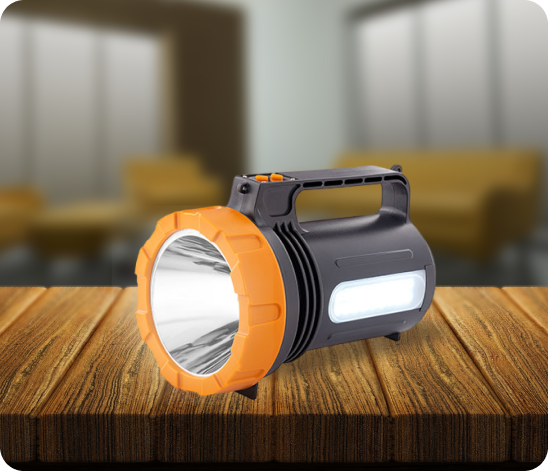The Future of Flashlight Technology: Rechargeable LED Innovations

Discover the latest advancements in rechargeable flashlight technology with innovative LED solutions.
The Rise of Rechargeable Flashlights
Rechargeable flashlights have become increasingly popular in recent years due to their convenience and sustainability. Unlike traditional flashlights that require disposable batteries, rechargeable flashlights can be easily powered up using a variety of methods, such as USB charging, solar power, or hand-cranking. This eliminates the need to constantly purchase and dispose of batteries, making rechargeable flashlights a more cost-effective and environmentally friendly choice.
In addition to their eco-friendly benefits, rechargeable flashlights also offer improved performance and durability. Many models feature high-quality LED bulbs, which provide bright and long-lasting illumination. LED technology has revolutionized the flashlight industry, offering greater energy efficiency and longevity compared to traditional incandescent bulbs. With a rechargeable LED flashlight, users can enjoy reliable and powerful lighting for extended periods of time without worrying about dimming or battery replacement.
Benefits of Rechargeable LED Technology
Rechargeable LED flashlights offer several key advantages over traditional flashlights. One of the major benefits is their energy efficiency. LED bulbs consume significantly less power than incandescent bulbs, allowing rechargeable LED flashlights to last much longer on a single charge. This is especially beneficial in emergency situations or outdoor activities where a reliable light source is essential.
Another advantage of rechargeable LED flashlights is their durability. LED bulbs are solid-state devices, meaning they have no fragile filaments or glass components that can break easily. This makes them more resistant to shocks, impacts, and vibrations, making rechargeable LED flashlights suitable for use in rugged environments.
Furthermore, rechargeable LED flashlights are more environmentally friendly compared to disposable battery-powered flashlights. By using rechargeable batteries or built-in rechargeable systems, these flashlights reduce the amount of battery waste that ends up in landfills. This contributes to a greener and more sustainable future.
Lastly, rechargeable LED flashlights often come with additional features and functionalities, such as adjustable brightness levels, strobe modes, and SOS signals. These added features enhance the versatility and usefulness of the flashlight, making it a valuable tool for various applications.
Innovations in Rechargeable Flashlight Design
The field of rechargeable flashlight design has seen significant advancements in recent years. One notable innovation is the integration of USB charging ports. Many rechargeable flashlights now come with built-in USB ports, allowing users to conveniently recharge their flashlights using common USB cables and power sources such as computers, power banks, or car chargers.
Another innovation is the development of solar-powered rechargeable flashlights. These flashlights feature solar panels that convert sunlight into electricity, which can be stored in the flashlight’s rechargeable battery. Solar-powered rechargeable flashlights are particularly useful in outdoor settings where access to electricity may be limited.
Additionally, there have been advancements in the compactness and portability of rechargeable flashlights. Manufacturers are continuously working on reducing the size and weight of flashlights without compromising their performance. This makes rechargeable flashlights more portable and easy to carry, making them ideal for camping, hiking, and emergency situations.
Furthermore, rechargeable flashlights have also started incorporating intelligent circuitry and smart features. These flashlights may include features such as battery level indicators, overcharge protection, and adjustable lighting modes. These innovations enhance the user experience and make rechargeable flashlights even more user-friendly and reliable.
Environmental Impact of Rechargeable Flashlights
Rechargeable flashlights have a significantly lower environmental impact compared to traditional flashlight models that rely on disposable batteries. Disposable batteries contribute to electronic waste and can leak harmful chemicals into the environment if not disposed of properly.
By using rechargeable flashlights, users can reduce the amount of battery waste generated. Rechargeable batteries can be reused multiple times before they need to be replaced, reducing the demand for new batteries. This helps conserve natural resources and minimizes the negative impact on the environment.
Furthermore, rechargeable flashlights often incorporate energy-efficient LED bulbs, which consume less power compared to incandescent bulbs. This reduces the overall energy consumption and carbon footprint associated with flashlight usage.
Choosing rechargeable flashlights over disposable battery-powered flashlights is a small but impactful step towards a more sustainable future. By embracing rechargeable technology, individuals can contribute to reducing electronic waste and protecting the environment.
Future Trends in Rechargeable LED Innovations
As technology continues to advance, we can expect to see further innovations in rechargeable LED flashlights. One potential trend is the integration of wireless charging capabilities. Wireless charging allows users to simply place their flashlight on a charging pad or dock to recharge the battery, eliminating the need for physical connectors or cables.
Another possible future trend is the development of even more compact and lightweight rechargeable flashlights. Advancements in battery and LED technology may allow for the creation of smaller yet more powerful flashlights that are easier to carry and store.
Furthermore, there may be advancements in the energy efficiency of rechargeable LED flashlights. Researchers are constantly working on improving the efficiency of LED bulbs, which could result in flashlights that provide even longer battery life and brighter illumination.
Additionally, smart features and connectivity options may become more prevalent in rechargeable LED flashlights. For example, flashlights could be equipped with Bluetooth or Wi-Fi capabilities, allowing users to control and monitor their flashlight settings using a smartphone app.
Overall, the future of rechargeable LED flashlight technology looks promising, with potential advancements in wireless charging, compactness, energy efficiency, and smart features. These innovations will continue to enhance the usability, convenience, and sustainability of rechargeable flashlights, making them an indispensable tool for various applications.

1 Comment
🔐 Reminder- TRANSFER 1,568380 bitcoin. Next >> https://yandex.com/poll/enter/BXidu5Ewa8hnAFoFznqSi9?hs=f0e9a59ab174b399f516d10fcec6aeee& 🔐
June 3, 20252mugff